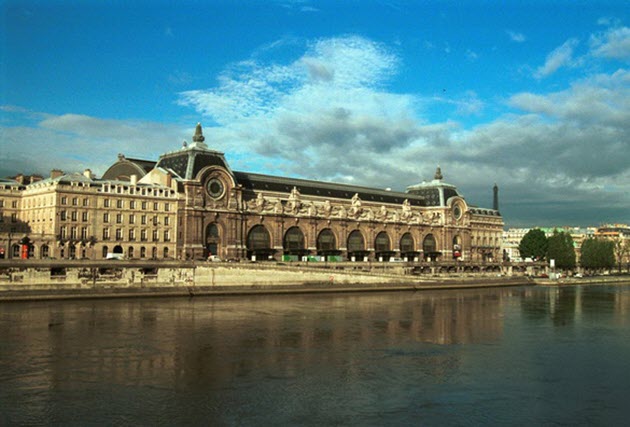ORSAY EXPRESSIONS
“When you go to Paris, you have to spend at least one day in the Louvre, though it's not enough to see the whole collection. I think it was open until 9:30 p.m. on Wednesdays. Also try to see the Musee d'Orsay, but it's a lot smaller compared to the Louvre, a couple of hours are enough for that.”
These lines pertaining to Paris -- the city that I have always identified with the arts, especially painting – are what I had heard from those lucky members of the group of people who had been there. Now, having “been there and done that” myself, I can say that the speaker couldn't have been more wrong in giving the Musee d'Orsay less importance than the Louvre.
I didn't have prior knowledge of what was in the Musee d’Orsay’s collections, but I knew that I would want to see everything, whatever it was. That being said, although I appreciate paintings of any kind, I do have preferences in styles. I tend to prefer Realist to Pre-Raphaelite works in that they act as historical documents, showing the social conditions at the time; and Expressionist painters to Impressionists, because art is for Expressionists a way of existence, a means through which they express their feelings and show their inner worlds.
I have always admired Van Gogh paintings for their power of making me feel things I wasn't aware I could feel before. I can't quite remember when I first saw his work -- since my mother is a painter, I grew up with paintings all around the house. But my earliest memory of how I felt about Van Gogh is something that happened in a science class in school when I was ten. We were doing an experiment: using three primary colors to get white light, and then using a prism to obtain the colors from white light. My teacher was astonished to hear a child of my age say: “The colors make different impressions on people. Red represents warmth and passion, while yellow is identified with madness. We can also see the frequent use of yellow in Van Gogh's paintings.” I couldn't understand why she was so surprised to come across a child who was familiar with Van Gogh, for I was sure that everyone was familiar with this artist who painted unbelievably beautiful sunflowers, which my mother and I had painted our own copy of.
 Having been a Van Gogh admirer for so long, I was delighted to discover that the Musee d'Orsay has the world’s second largest Van Gogh collection (next to the Van Gogh Museum in Amsterdam). After walking through galleries with Monet's waterlilies and Degas's ballerinas, seeing Van Gogh's “La nuit étoilée” (Starry Night) was like arriving at the top of a steep ladder reaching the sky -- for I did reach the sky. Drawing a starry night was an idea that had haunted Van Gogh for years by the time he painted it in 1888, only a short while before he would admit himself to a mental institution. Knowing this, and looking at this painting that is identified with serenity, the viewer may see it as a sign of the storm about to come. And this couldn't be more right, for the storm did come in the second version of the painting which he did a few months later, where the sparkling gemstones in the sky turn into flames.
Having been a Van Gogh admirer for so long, I was delighted to discover that the Musee d'Orsay has the world’s second largest Van Gogh collection (next to the Van Gogh Museum in Amsterdam). After walking through galleries with Monet's waterlilies and Degas's ballerinas, seeing Van Gogh's “La nuit étoilée” (Starry Night) was like arriving at the top of a steep ladder reaching the sky -- for I did reach the sky. Drawing a starry night was an idea that had haunted Van Gogh for years by the time he painted it in 1888, only a short while before he would admit himself to a mental institution. Knowing this, and looking at this painting that is identified with serenity, the viewer may see it as a sign of the storm about to come. And this couldn't be more right, for the storm did come in the second version of the painting which he did a few months later, where the sparkling gemstones in the sky turn into flames.
Before I left the museum, I also had a chance to exchange glances with Van Gogh as I stood before a work completed a year before he died ("Self-Portrait," 1889). The artist painted more than forty self-portraits in search of a better likeness of himself than in a photograph, explaining the unusual coloring and brushwork of this painting, which doesn't really resemble a portrait. The portrait not only shows how he looks but also holds a mirror up to his personality and inner world. His eyes tell us that he is a man in agony searching for tranquility.
But I had in fact collected my clues about the artist’s character from each of the twenty-six paintings in the gallery. I left with a smile on my face, due to a strange mixture of feelings: a thrill at having finally seen the paintings I had longed to see for so many years; calmness, for some of his paintings indeed have the tranquilizing power Van Gogh wished them to have; but also some anger with the world for having denied him the happiness he deserved.
“The Louvre has an unbelievably rich collection of both paintings and sculpture. Even the building itself is a work of art. Going to the Louvre is an opportunity that should not be missed by any art lover. However, if you don't have the time and it’s post-1800 paintings that you’re mostly interested in, it’s out of the question not to visit the Musee d'Orsay. Everyone deserves to see the world through Van Gogh's eyes.”
-1.jpg)